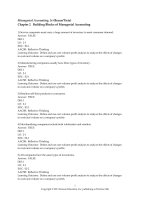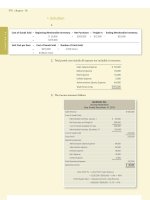Financial managerial accounting 3rd kieso ch18(cost volume profit)
Bạn đang xem bản rút gọn của tài liệu. Xem và tải ngay bản đầy đủ của tài liệu tại đây (2.15 MB, 79 trang )
Financial & Managerial
Accounting
3
rd
Edition
Jerry Weygandt, Paul Kimmel, Don Kieso
Prepared by
Coby Harmon
University of California, Santa Barbara
Westmont College
18-1
Cost-Volume-Profit
CHAPTER 18
Chapter Outline
LEARNING OBJECTIVES
18-2
LO 1
Explain variable, fixed, and mixed costs and the relevant range.
LO 2
Apply the high-low method to determine the components of mixed costs.
LO 3
Prepare a CVP income statement to determine contribution margin.
LO 4
Compute the break-even point using three approaches.
LO 5
Determine the sales required to earn target net income and determine margin of safety.
LEARNING OBJECTIVE 1
Cost Behavior Analysis
Explain variable, fixed, and mixed costs and the
relevant range.
Cost Behavior Analysis is the study
of how specific costs respond to changes in the level of business activity.
18-3
Some costs change; others remain the same.
Helps management plan operations and decide between alternative courses of action.
Applies to all types of businesses and entities.
Starting point is measuring key business activities.
LO 1
Cost Behavior Analysis
Cost Behavior Analysis is the study of how specific costs respond to changes in the level of business
activity.
18-4
Activity levels may be expressed in terms of:
►
Sales dollars (in a retail company)
►
Miles driven (in a trucking company)
►
Room occupancy (in a hotel)
►
Dance classes taught (by a dance studio)
Many companies use more than one measurement base.
LO 1
Cost Behavior Analysis
Cost Behavior Analysis is the study of how specific costs respond to changes in the level of business
activity.
18-5
Changes in the level or volume of activity should be correlated with changes in costs.
Activity level selected is called activity or volume index.
Activity index:
►
Identifies the activity that causes changes in the behavior of costs.
►
Allows costs to be classified as variable, fixed, or mixed.
LO 1
Variable Costs
Costs that vary in total directly and proportionately with changes in the activity level.
►
Example: If the activity level increases 10 percent, total variable costs increase 10 percent.
►
Example: If the activity level decreases by 25 percent, total variable costs decrease by 25
percent.
18-6
Variable costs remain the same per unit at every level of activity.
LO 1
Variable Costs
Illustration: Damon Company manufactures tablet computers that contain a $10 camera. The activity index is the
number of
tablets produced. As Damon manufactures each tablet, the total cost
of the cameras used increases by $10. As part (a) of ILLUSTRATION
18.1 shows, total cost of the cameras will be $20,000 if Damon
produces 2,000 tablets, and $100,000 when it produces 10,000
tablets. We also can see that a variable cost remains the same per
unit as the level of activity changes.
ILLUSTRATION 18.1
Behavior of total and unit variable costs; variable costs per unit remain
constant
18-7
LO 1
Variable Costs
Illustration: Damon Company manufactures tablet computers that contain a $10 camera. The activity index is the
number of
tablets produced. As Damon manufactures each tablet, the total cost
of the cameras used increases by $10. As part (b) of ILLUSTRATION
18.1 shows, the unit cost of $10 for the camera is the same whether
Damon produces 2,000 or 10,000 tablets.
ILLUSTRATION 18.1
Behavior of total and unit variable costs; variable costs per unit remain
constant
18-8
LO 1
Variable Costs
ILLUSTRATION 18.1
Behavior of total and unit variable costs; variable costs
per unit remain constant
18-9
LO 1
Fixed Costs
Costs that remain the same in total regardless of changes in the activity level within a relevant
range.
Fixed cost per unit cost varies inversely with activity: As volume increases, unit cost
declines, and vice versa
18-10
Examples:
►
Property taxes
►
Insurance
►
Rent
►
Supervisory salaries
►
Depreciation on buildings and equipment
LO 1
Fixed Costs
Illustration: Damon Company leases its productive facilities at a cost of $10,000 per month. Total fixed costs of the
facilities will remain constant at every level of activity, as part (a) of
ILLUSTRATION 18.2 shows.
ILLUSTRATION 18.2
Behavior of total and unit fixed costs
18-11
LO 1
Fixed Costs
Illustration: Damon Company leases its productive facilities at a cost of $10,000 per month. Total fixed costs of the
facilities will remain constant at every level of activity. But, on a per
unit basis, the cost of rent will decline as activity increases, as
part (b) of ILLUSTRATION 18.2 shows. At 2,000 units, the unit cost
per tablet computer is $5 ($10,000 ÷ 2,000). When Damon produces
10,000 tablets, the unit cost of the rent is only $1 per tablet ($10,000 ÷
10,000).
ILLUSTRATION 18.2
Behavior of total and unit fixed costs
18-12
LO 1
Fixed Costs
ILLUSTRATION 18.2
Behavior of total and unit fixed costs
18-13
LO 1
Fixed Costs
Question
Variable costs are costs that:
18-14
a.
Vary in total directly and proportionately with changes in the activity level.
b.
Remain the same per unit at every activity level.
c.
Neither of the above.
d.
Both (a) and (b) above.
LO 1
Relevant Range
Throughout the range of possible levels of activity, a straight-line relationship usually does
not exist for either variable costs or fixed costs.
Relationship between variable costs and changes in activity level is often curvilinear.
For fixed costs, the relationship is also nonlinear –
some fixed costs will not change over the entire range
of activities, while other fixed costs may change.
18-15
LO 1
Relevant Range
ILLUSTRATION 18.3
Nonlinear behavior of variable and fixed costs
18-16
LO 1
Relevant Range
Range of activity over which a company expects to operate during a year.
ILLUSTRATION 18.4
Linear behavior within relevant range
18-17
LO 1
Relevant Range
Question
The relevant range is:
18-18
a.
The range of activity in which variable costs will be curvilinear.
b.
The range of activity in which fixed costs will be curvilinear.
c.
The range over which the company expects to operate during a year.
d.
Usually from zero to 100% of operating capacity.
LO 1
Mixed Costs
Costs that have both a variable element and a fixed element.
Change in total but not proportionately with changes in activity level.
ILLUSTRATION 18.5
Behavior of a mixed cost
18-19
LO 1
DO IT! 1
Types of Costs
Helena Company, reports the following total costs at two levels of production.
Classify each cost as variable, fixed, or mixed.
Variable
Fixed
Mixed
18-20
LO 1
LEARNING OBJECTIVE 2
High-Low Method
Apply the high-low method to determine the
components of mixed costs.
High-Low Method uses the total
costs incurred at the high and the low levels of activity to classify mixed costs into fixed and
variable components.
The difference in costs between the high and low levels represents variable costs, since only
variable-cost element can change as activity levels change.
18-21
LO 2
High-Low Method
STEP 1: Determine variable cost per unit using the following formula:
ILLUSTRATION 18.6
Formula for variable cost per unit using high-low method
18-22
LO 2
High-Low Method
Illustration: Metro Transit Company has the following maintenance costs and mileage
data for its fleet of buses over a 6-month period.
ILLUSTRATION 18.7
Assumed maintenance costs and mileage
data
Change in Costs
(63,000 - 30,000)
$33,000
=
High minus Low
18-23
(50,000 - 20,000)
30,000
$1.10
cost per unit
LO 2
High-Low Method
STEP 2: Determine the total fixed cost by subtracting the total variable cost at either the high or the low activity
level from the total cost at that activity level.
ILLUSTRATION 18.8
High-low method computation of fixed costs
18-24
LO 2
High-Low Method
Maintenance costs are therefore $8,000 per month of fixed costs plus $1.10 per mile of variable costs. This is
represented by the following formula:
Maintenance costs = $8,000 + ($1.10 x Miles driven)
Example: At 45,000 miles, estimated maintenance costs would be:
Fixed
Variable
$ 8,000
($1.10 x 45,000)
49,500
18-25
$57,500
LO 2









